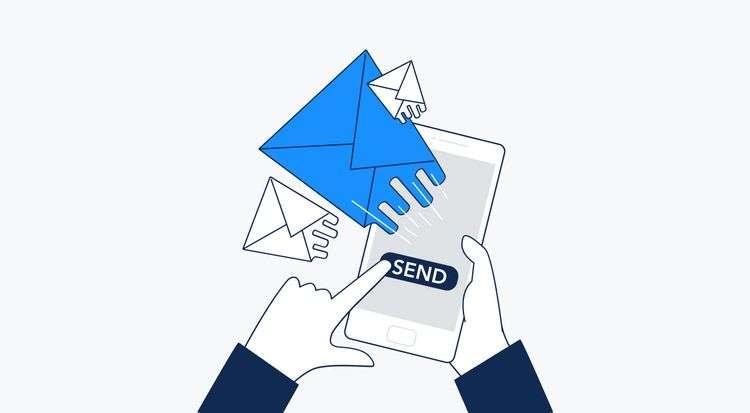- What is a follow-up email
- Funny follow-up email after no response
- Should I resend an email if no response
- What causes prospects to ignore your email
- How to send a follow-up email
- When to send a follow-up email
- What to include in a follow-up email
- How to follow up when someone doesn't respond
- Follow-up email examples
- Summary about sending a follow-up email after no response
Ignoring your message doesn't automatically mean refusing to collaborate. Many factors, from distractions to vacations or illnesses, can cause silence. It's well-known that a single contact attempt can eliminate half your chances.
An effective follow-up email is crucial, yet it doesn't mean sending six identical «just checking in» emails. Each of them should be unique, human, and contextually relevant, aiming for a response by considering the recipient's perspective.
Read the article about follow-up emails, their importance, how to create them properly, and scenarios of what to do with your follow-up email after no response.
What is a follow-up email
A follow-up email is a message you send after you’ve already contacted a person, though you didn’t reach your goal from the first email (a reply, a meeting, a decision, etc.).
Funny follow-up email after no response
Just as an example (create a template from HubSpot) of how a potential client-grabbing email sequence might look to get them interested enough to actually click on it and respond to you. It doesn’t have to be overly serious. Add a touch of humor, but base it on what kind of humor your target audience would appreciate.
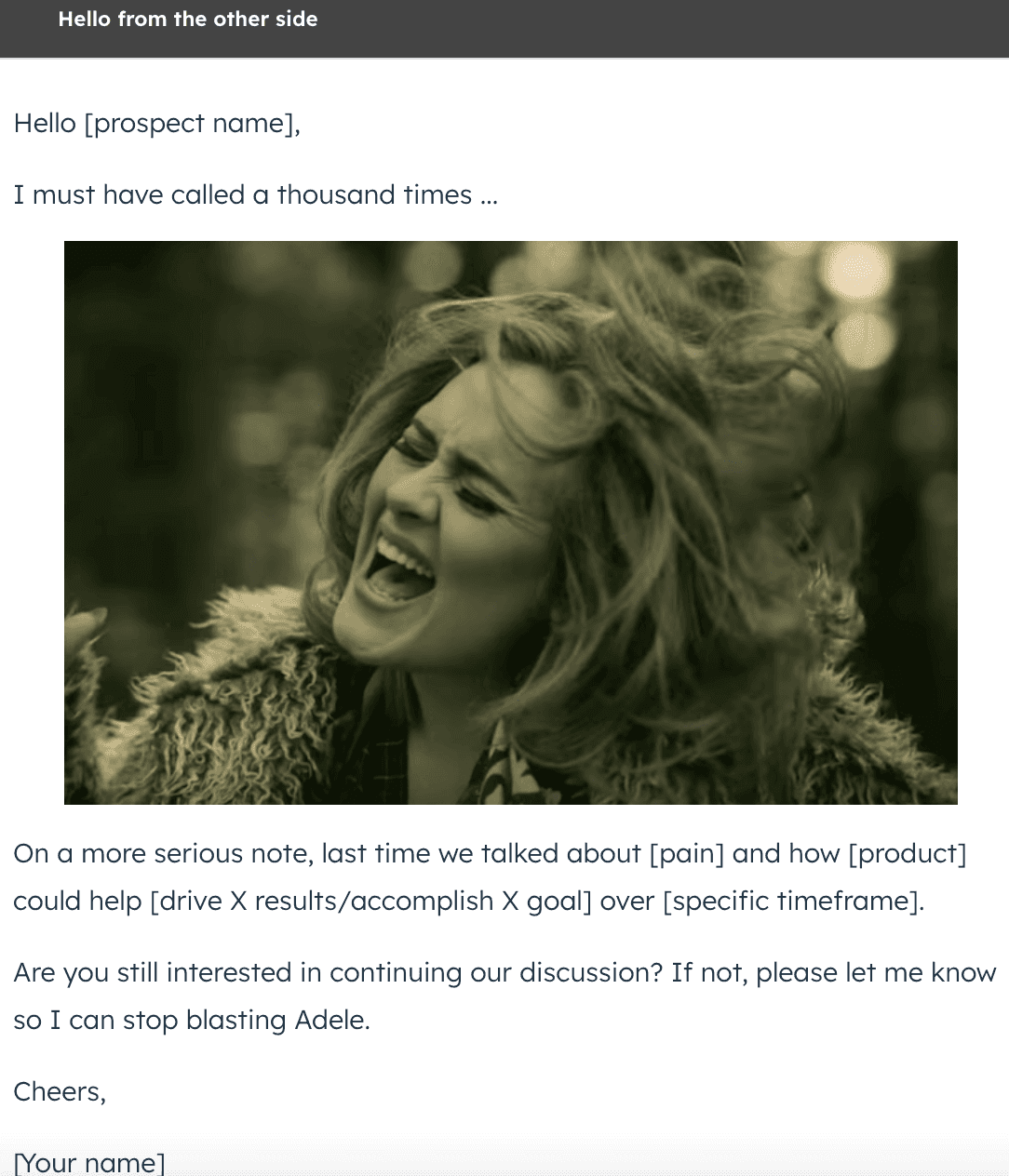
Source: HubSpot
Should I resend an email if no response
Of course! If the first cold emails go unnoticed, it may indicate that the recipients opened but overlooked them amid daily tasks.
The reasons can be many and it is not always disinterest in your offer. Review your first emails, correct mistakes, and begin follow-ups again — using AI for cold email can help make your outreach more effective, ensuring messages reach the right people at the right time with personalized content.
What causes prospects to ignore your email
We often struggle to get responses from popular guys who are correspondingly busy. Below we collected a few reasons, so you don't feel embarrassed or think you'll sound aggressive with your business email follow-up.
- Missed the first email among the piles of others in their inbox.
- They opened your first message, started reading, and then got distracted. When they came back, your email was hidden under many new ones.
- They understood the need to read the email later in detail, marked it unread, then procrastinated, and finally deleted it.
- They basically ignore all cold emails, or you simply send them to the wrong person who isn't responsible for such issues in the company.
What you need to do with a follow-up sales email after no response (a hint for a quick search).
Use the GetProspect B2B database to find colleagues of the contact you sent a cold email to, those who are more likely to respond to you and be responsible for making decisions.
You can search for data in a B2B database with 17+ search filters or enrich the data in a single format in the Enrich block. Here's how you can reach your contacts’ employees.
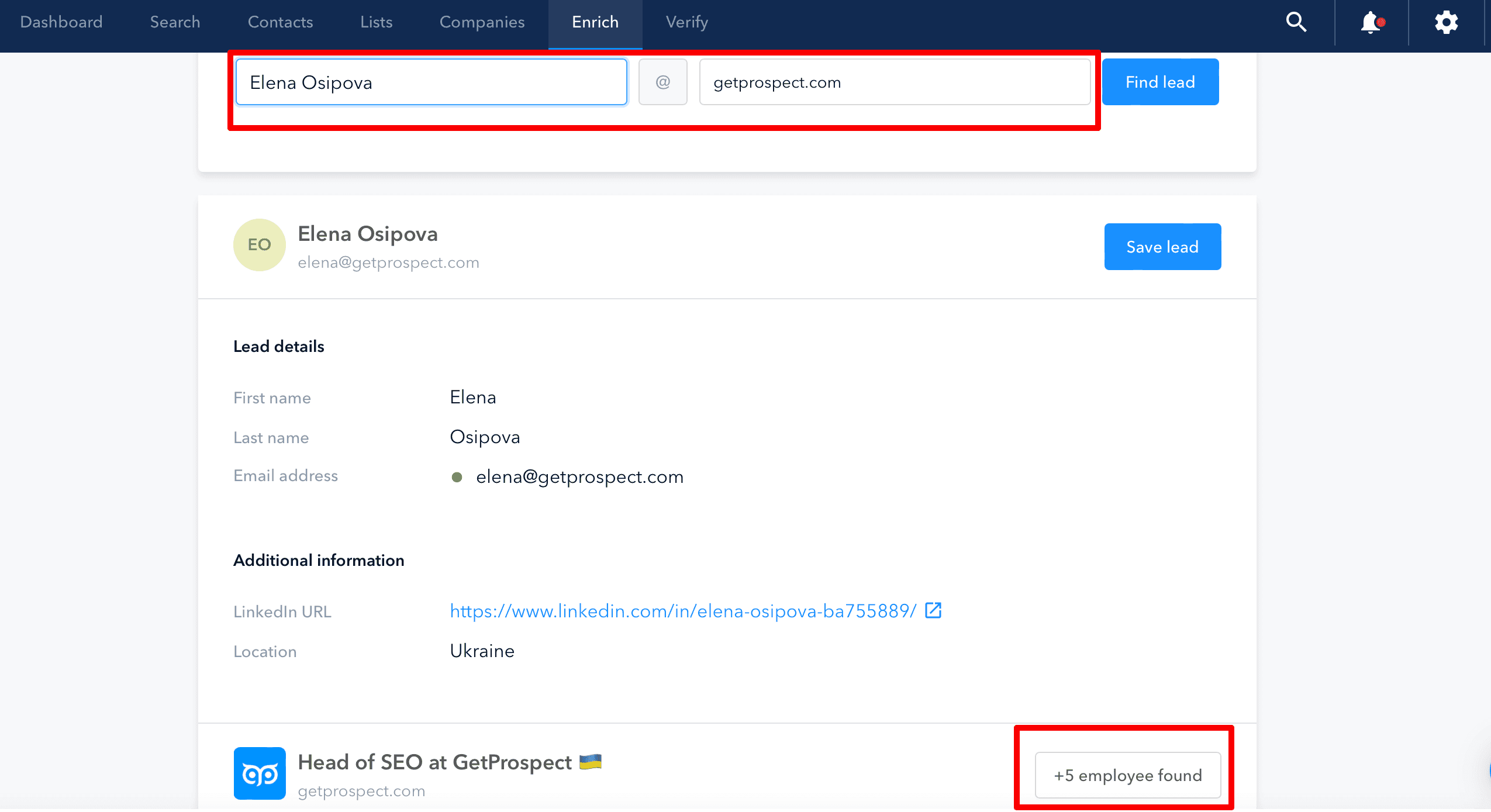
If your follow-ups dont get a response, you might be trying to reach the wrong person. Find the most relevant leads with GetProspect, the most reliable B2B database.
Try it for free- They basically skip emails on a certain subject. So they’ll ignore even the perfect follow-up email.
- The subject line is boring and looks spammy.
Before sending a follow-up email after no response, please check your subjects with tools like Moosend, Mailmeteor, or CoSchedule. With the help of such solutions, you can check your subject lines for spammy words and the correct subject line length and optimize your headlines according to important criteria.
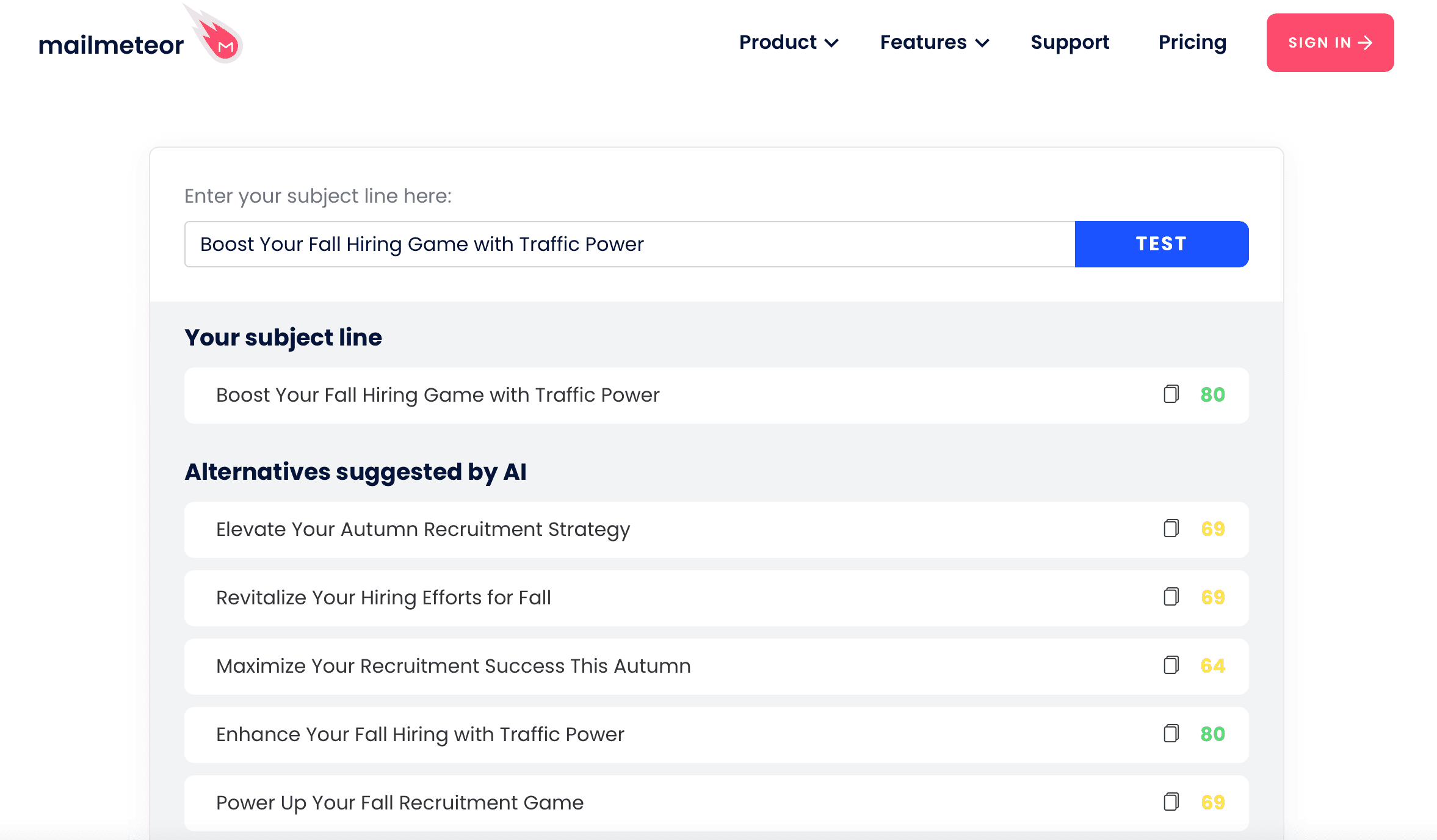
Learn more about how to create the perfect cold email subject line and get 60+ examples for free here.
-
They expect you will sell something and avoid it.
To create the best follow-up email after no response, you need to customize the most accurate company emails possible to hook the recipient from the first words in the subject line.
It should not look like an annoying sales pitch, but a really great offer, a cool alternative to the product your potential customer is using.
Use the Technologies filter and others to send your offers to contacts who would be interested. For example, you own a product/platform that allows you to customize Marketing automation. You need to find people who use similar solutions to yours and choose a Location and business size (all according to your ideal customer profile). Plus, choose a decision-maker position via the Job title filter.
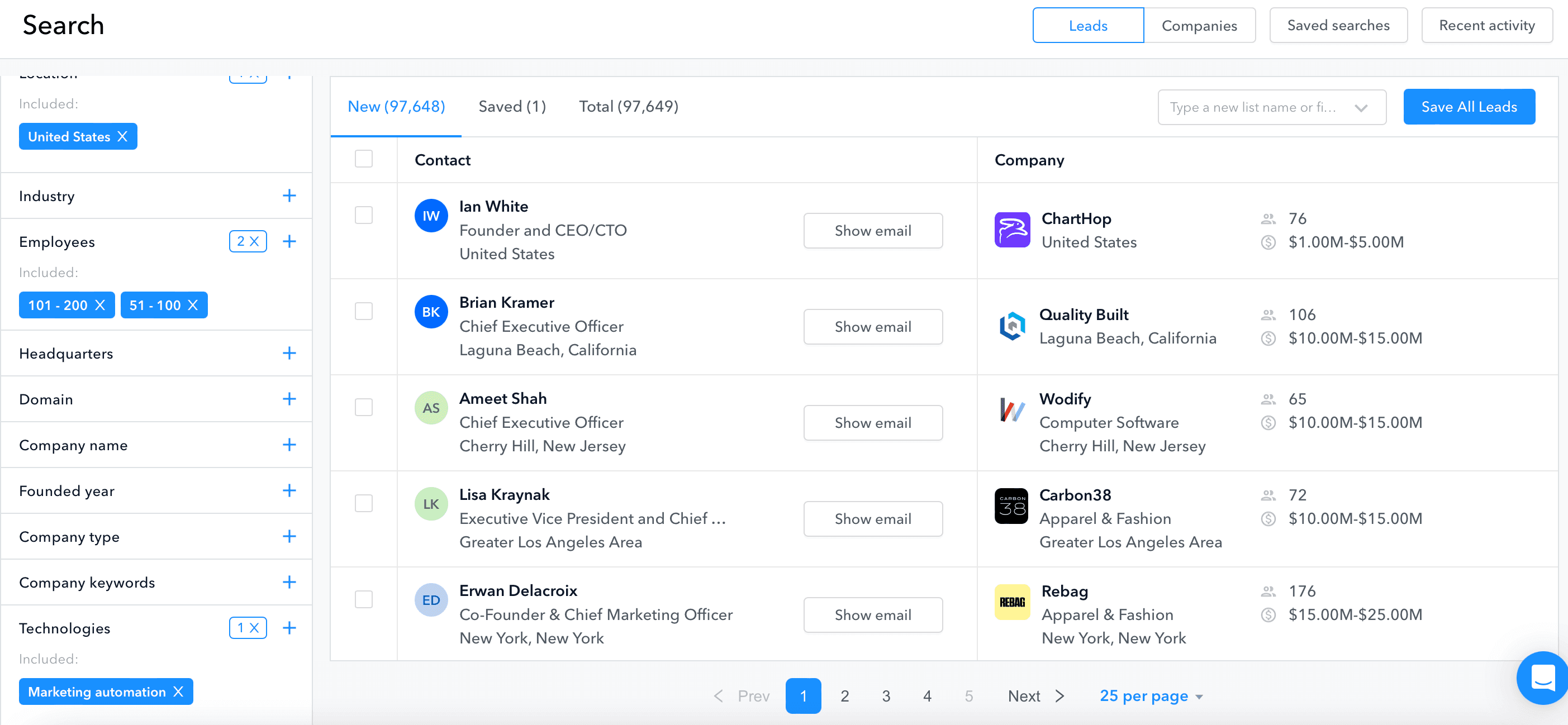
This way, you will gather a list of people who will be up for an offer from you if you give enough facts about why your platform is better than your competitors.
- The email isn’t urgent, and they put it off.
- They are on vacation or sick leave.
- And so on.
With the app, you can find all prospects valid professional emails.
Discover more emailsHow to send a follow-up email
Here are some considerations to keep in mind when planning your follow-ups:
- You don’t need follow-ups in some cases
- Adopt a number of follow-ups for your audience
- Try various tones and formats
- Focus on one fact/idea per follow-up
Follow-ups aren't worth the effort in some cases
You have a market of millions of potential clients/partners/you name it. In this case, it turns out that it is more cost-effective to outreach new prospects than to follow up. The first email is more likely to be answered. With each next sales follow-up email, the likelihood decreases. Simple maths.
Here is the Yesware data, e.g., you have a 30% likelihood to get a reply on the first email and 10% — on the 8th email.
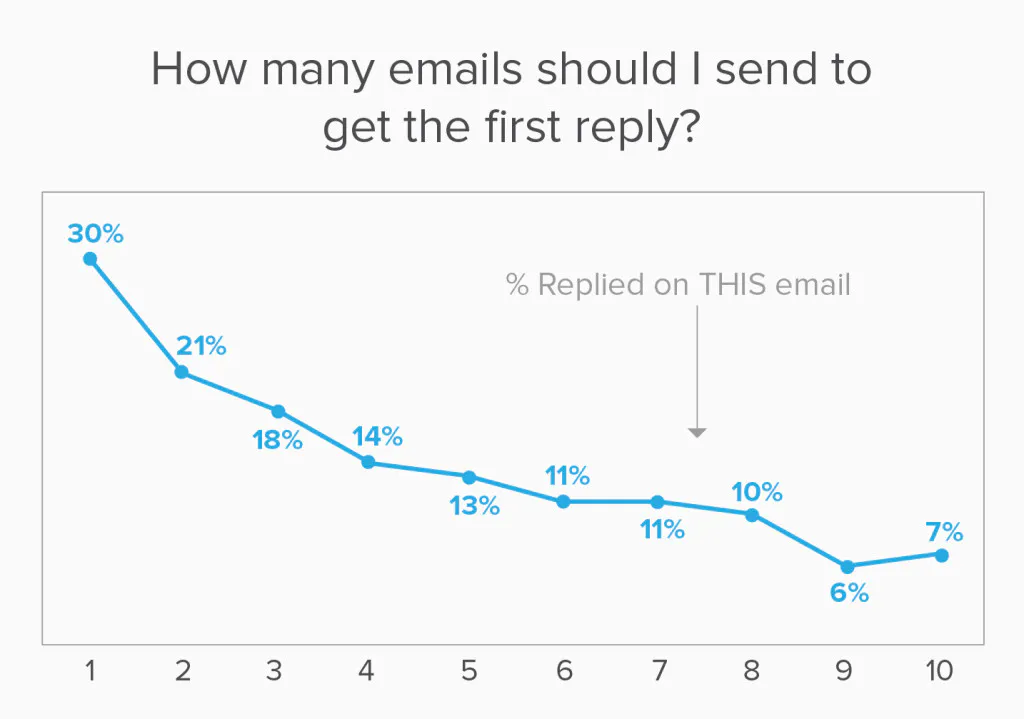
Determine how many follow-ups will fit your audience
You might need 10-13 follow-ups in enterprise sales, and only 1-2 make sense in link-building and journalist outreach.
In the U.S., it's normal to send 7 follow up sales emails, in the EU, it's 4, and in Japan, it's even less and less frequent.
With cold outreach, it's a good idea to stop at some point (6-7th email), while with warm leads, you can send an infinite number of unopened emails until the recipient unsubscribes.
Experiment with tones and formats
Even if you know your audience perfectly, you don’t know the exact personality on the other side of the screen. So we recommend testing various techniques with each effective follow-up email. You can even automate it.
Gentle reminder polite follow-up email sample after no response:
| Subject: A deal you can’t refuse! | {{Your Company Name}} |
|
Hi {{Prospect name}}, Just following up to understand if you are interested in going ahead with the proposal mentioned in the previous email. Please let me know so that I can help you. _ Best, {{Signature}} |
Useful follow-up email sample after no response:
| Subject: Increase email open rate by N% |
|
Hey again {{Prospect name}}, No word from you but I still need you to avoid antispam filters Here are our {{Add useful guide from your blog on this topic. For example, N Deliverability Checks}} so you can keep it all safe. Do you need any assistance with the list? _ Best, {{Signature}} |
Idea per follow-up
Avoid pulling all your research into one writing. First, it is creepy for a prospect — «he's watching me?» Second, you spend all reasons for reaching out at once, though you could add one fact across your pings.
Focus on one fact/idea per follow-up instead.
When to send a follow-up email
The first follow-up is better to send in 1-2 days, so the recipient has time to check it. The 2d ping and 3rd follow up email are sent during the same week with similar time gaps. 4th-6th are sent every week.
Tip: During 4-6 pings, start contacting other people from the company.
We recommend:
- Variate your sending days and times. You never know the exact timetable of the recipient. So you can just guess when they check their inbox.
- Avoid too frequent follow up sales emails. You may seem aggressive and overly salesy.
- Make time gaps appropriate for your audience. E.g., you can send the first follow-up for a US prospect in 2 days, though you’d better wait 2 weeks in the case of a Japanese prospect.
What to include in a follow-up email
The content of each new sales follow-up email should bring benefit to the recipient. Even if the potential clients were skeptical about your first email, they might change their minds with your new reasons. They may respect you for your quality work and respond just based on the grounds.
- A client's feedback from the company in the same field
- Diagrams that show the results they can expect
- Blogs, e-books, guides — any unique content that will be helpful
- Your case studies
- GIFs and memes to make them smile
- Summary from a piece of niche news
- Tell about one of their competitors, what they do, and their progress
- And more
Note. If you add this data, it means you don’t just remind yourself to refer to your first message. You furnish each cold email follow-up with a new explanation of why prospects should respond to you.
How to follow up when someone doesn't respond
If you didn't receive a response, first, confirm that the email was received and consider whether the Time Zone was set correctly. Make sure you have chosen the right email marketing platform with a contact database update feature to send valid email addresses.
Try a different approach. Perhaps add humor or facts instead. Be sure to personalize your cold emails and offer value in the subject line to encourage a response.
With
Follow-up email examples
- First contact after no reaction
- Second follow-up email after no response
- Third follow-up email after no response
- You don’t get a response on other channels
- The recipient ghosted
- A lead «isn’t interested» in your offer
- You sent >7 follow-ups with silence in response
- A potential client unsubscribes or strictly refused
Below are suggestions for message content in various scenarios. Take the offered versions and adapt them to your audience.
Follow-up email sample: First business follow-up email sample after no response
Assuming your first message just gets lost in the recipient’s inbox, the first ping may have less value. So-called «bump» emails get your initial message an extra chance of being seen. Send the message in the thread with the first email. «Bump» emails are fast, straight to the point, and easy to respond to. That’s why the tactic often gets a reasonable response rate.
Here is a follow-up email after no response template:
| Subject: Re: {{companyName}} + e.ventures |
|
Hey {{firstName}}, Have you checked my previous email? It would be great to connect over an introductory call in the coming days or weeks. I'd be happy to elaborate on our investment thesis and how we like to be helpful to businesses outside of just a capital injection. {{link to book a call}} _ {{signature}} |
Second follow-up email after no response
The second follow-up email doesn't have to be long. You just need to try to reach out to the prospect again or remind them about yourself, so they may have time to read your offer. And add some useful information, for example, links to useful guides from your blog, which will be valuable to the recipient.
Follow-up letter sample after no response:
| Subject: Re: I've seen your Start-up profile on Launch DXB |
|
Hi {{firstName}} Hope you are well! Have you reviewed my previous email? Also please have a look at our blog post about steps for MVP launch development for startups. I hope you'll find it interesting! _ Best regards, {{signature}} |
Third follow-up email after no response
Here, you can make a special offer or a discount. Indicate it in the email subject line.
| Subject: Special offer just for you😉 |
|
Hi {{Prospect name}}, If you are interested in going forward with [Company name], I can help you get a 20% discount on our annual subscription. Kindly let me know your thoughts on this. I will assist you further. _All the best, {{signature}} |
Follow-up email sample: You don’t get a reply on other channels
If you are applying a multi-channel cadence, email is most likely one of your steps. For instance, you connected and messaged them on LinkedIn. Then, with their name and company name, you find their email using a contact enrichment tool. Now you want to craft the second follow-up email template.
Extra info after LinkedIn message:
| Subject: promised to send you the {{video_article_presentation_document_etc}} |
|
Hi! I contacted you on LinkedIn and promised to send you extended information on dealing with {{customer_problem}}. Would you be open for a 10-minute call on Monday or Tuesday at 4 pm so I can explain the document? _ All the best, {{signature}} |
Business follow-up letter sample after non-business related LinkedIn chat
|
Subject: Question? |
|
Hello {{firstName}}, We recently got in touch on LinkedIn, I'm Louis. The resurgence of COVID-19 will cause you to think about new ways to disinfect your public places. I am offering an innovative disinfection solution, effective (99.99%), durable (1 year of disinfection after application), and above all, eco-responsible. All while respecting your budget line. Do you have time next week for a short introduction call? Thank you in advance for your return, _ Regards, {{signature}} |
Follow-up email sample: Your prospect ghosted
Let’s imagine you sent the first email, and they positively replied, you proceed and ask for a meeting, and then…silence. Or they agreed to sign up imminently and again… nothing has happened since then.
There are cases when prospects seem interested, though they don’t proceed with any conversation. Here we provide several samples of reminder email for no response.
1. You agreed they would contact you in 2 months
| Subject: Talked in December. What’s next? |
|
Good morning, {{first_name}}. Fantastic weekend? We had a couple of convos in December about cold call outreach effectiveness for your team, talked about some next steps right after the holidays, and I noticed we hadn’t gotten that time scheduled yet. I think one of a few things may have happened:
If you face these or other reasons, let me know if you are ready to proceed with us? I’m OK with any response, simply don’t like to assume (I’m typically wrong when I do) :) Talk soon! {{signature}} |
2. Quick follow-up when you agreed they would test your tool
| Subject: on our arrangements |
|
Hello, {{first_name}}! 3 weeks ago, we agreed you would test our tool. Maybe you have some doubts? Would you mind a 10 min call so we can discuss your experience with {{name_of_the_tool}}? If you are more comfortable with email, messenger, or other communication formats, I am open to any. _ Regards, {{signature}} |
3. Reminder email sample after no response
| Subject: Follow-up |
|
Hello {{Prospect name}}, I hope this message finds you well. I wanted to quickly follow up regarding my previous email about {{repeat your offer}}. If you've had a chance to review the suggestion or if there's any additional information needed from our end, please let me know. Your consideration is much appreciated. Thank you for your time. _ Best regards, {{signature}} |
Follow-up email sample: A prospect «isn’t interested» in your offer
This cold email follow-up template is for the case when you are 99% sure they need it or use the alternative. For example, you know they just closed the investment round and need your financial tool. Check the samples or use them alongside your AI email writers.
1. Cold email follow-up for handling the objection
| Subject: Cases from uninterested clients |
|
Hi! {{first_name}}, I understand your decision. Most of our customers initially responded by not being interested because they didn’t know us. Would you like to know why they became customers? {{signature}} |
2. Follow-up email template with research specifically for their company
| Subject: What I get from researching {{marketing}} at {{company_name}} |
|
Hi! I caught your decision. It is absolutely OK. You might haven't had time to learn the full potential of {{product_name}} for you. I prepared a short summary of results your company can get in 6 months with {{product_name}}. Would you check? It will take several minutes. Thanks for your time. I hope this information helps you make a decision and would be happy to discuss it. _ {{signature} |
Follow-up email sample: You sent >7 follow-ups with no response
At this stage, you have nothing to lose. So it is time for a weird and creative sample follow-up email after no response from a client.
Here are 2 examples.
I had a client who ignored everything. I sent him a poem and added this.
Sending a follow-up email after no response sample:
|
«I hope while you were reading this poem over your morning coffee, you recalled me and will reply today». |
And he replied!
Matthew Roberts told us about his quick follow-up experience with FaceTime cold calls.
«One time, I booked a meeting with a CEO, and he mentioned he was going to tell his sales team to do the same (face-timing) — which I advised against and said i don't think its the best tactic, but in sales, you have to try everything, so we did :)»
Follow-up email sample: A prospect unsubscribes or strictly refused
In this case, you should leave them alone, THOUGH you have the last-chance email. Tell something extraordinary to catch their attention or at least make a good impression so that they will recommend your product to their friends, colleagues, business partners, clients, etc.
Follow-up email template of what you can send in the situation
|
Subject: I stop reaching you, but you need to know this |
|
Hi! You are unsubscribed from my messages. I have to notify you that {{one_of_their_main_competitors}} started to work with us last week. _ {{signature}} |
Follow-up email after no response:
| Subject: We’re Sad to See You Go 😢 |
|
Hi {{Lead name}}, We noticed that you have decided to unsubscribe. While we are sad to see you go, we respect your decision and thank you for giving us a chance. If you have a moment, we'd love to hear your feedback on what would make your experience with us better. Please fill out the short form below. If you ever want to explore {{platform name}} again, feel free to email us. Have a nice day, _ {{signature}} |
Tip. In case you badly need the client: 1. Contact their colleagues. 2. Outreach them through other channels while avoiding talks about business for some time.
Summary about sending a follow-up email after no response
- Prospects may ignore you. It is OK.
- Potential customers can ignore your email because they missed the first email among the piles of others in their inbox; they opened your first message, started reading, and got distracted; the subject line is boring and looks spammy.
- If the first cold emails go unnoticed, the timing might be off, or there's another reason.
- Add something helpful, interesting, or funny to your follow-up.
- Before sending a follow-up email after no response, please check your subjects with tools like Moosend, Mailmeteor, or CoSchedule. With the help of such solutions, you can check your subject lines for spammy words and the correct subject line length and optimize your headlines according to important criteria.
- Place one reason for contact per ping. Don’t overload your email.
- Choose the best (GetProspect) email marketing platform that will always provide you with valid emails of your contacts, where you can segment email lists, personalize emails, and analyze data after cold emails of follow-ups are launched.


